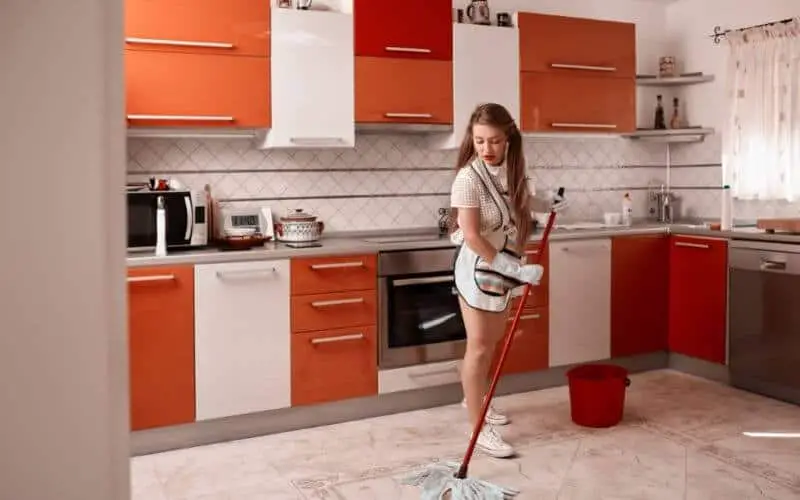Hardwood flooring is a very durable flooring type, but it is, however, susceptible to moisture. This is why it is best suited for areas with less moisture exposure.
This doesn’t mean you cannot install hardwood floors in moisture-prone areas like the kitchen, you can, but you would need to know how to protect hardwood floors in the kitchen so that you can keep your floor in its best condition for as long as possible.
You can do this by adopting proper care habits, seal the wood, and place kitchen mats on the area; this will help you retain your hardwood floor’s timeless beauty.
Read: How to get rid of maggot on kitchen floor
How to Protect Hardwood Floors in Kitchen
Table of Contents
Keep Water Off the Floor
Any source of moisture that goes undetected for a long time can damage a section of a hardwood floor by causing it to swell, warp, or even split.
Frequent water spillage also poses equal risk unless it’s wiped up quickly. If you live with other people, try to get them on the same page so that water spills are minimized and keep an eye out for the kitchen appliances.
This helps your hardwood kitchen floor to hold up better even as you regularly apply a polyurethane sealant every four to six years.
Opt For a Hardwood Floors
When choosing a hardwood floor for your kitchen, you might be overwhelmed by the number of attractive wood flooring options you would come across.
For moisture-prone areas like the kitchen, you need a wood species that’s hardy enough to withstand the high-impact traffic typical of kitchens.
There’s constant movement in and out of the area and the movement of chairs and stools, which could scratch or dent the floor.
Prevention, they say, is better than remedy; although there are some effective ways to repair scratches and dents on wood floors, these often diminish the beauty and appearance of the floor rather than fix your wood floors back to 100 percent again.
The hardness of various types of wood is rated using the Janka scale—the higher the rating, the harder the wood. You can find out the hardness rating of your desired wood floor by checking out the national wood flooring association’s Janka scale.
Hardwood, such as hickory or Brazilian walnut with a Janka rating over 1500, will withstand the high traffic in a kitchen better than a softer type of wood, like white ash or beech.
Manually Apply a Finish to the Planks.
Installing prefinished wood planks is way easier as you do not need to apply a finish as soon as the boards are nailed down. But for kitchens areas, prefinished flooring is not recommended.
Prefinished planks get their finished look after installation due to their slightly beveled edges. However, the slopes make it easier for the planks to absorb spills as it leaves tiny tracks between the boards.
Unfinished planks, however, are completely flat and are best suited for kitchen areas. After installing the planks, sand the entire surface before staining, and then seal the floor.
Apply a Sealant
A good sealant not only protects your wood floor from being easily damaged by water spots and scratches it also enables it to withstand traffic and spills in a kitchen.
There are two types of sealants; water-based and oil-based sealants, but a quality oil-based sealant is recommended for kitchen use as it will provide the best protection.
However, the downside to using an oil-based sealant is having to wait a long time before the sealant dries up; you may need to wait up to 24 hours before you can walk on the floor.
Read: How long does it take polyurethane to cure
Maintaining your Kitchen Floor
Regardless of the area, it is installed, following a proper care and maintenance routine will help to keep the floor in the best condition possible. Here are some tips to help you protect hardwood floors in kitchen
- Attend to spills immediately they occur.
- Regularly clean the floor using a soft cotton dust mop or a broom with soft rubber bristles that won’t scratch the floor’s finish.
- Don’t steam clean the floor as it could damage the finish.
- Attach furniture pads on the feet of kitchen tables and chairs to prevent them from leaving scratches or dents on the wood floor.
- Inspect underneath the sink and around the dishwasher and fridge for signs of leaking regularly and fix any discovered leak promptly.
- Place rugs and floor mats in high traffic areas to protect the wood flooring. Rugs catch and absorb small spills preventing them from reaching the flooring.
- Before moving any heavy appliances like a refrigerator, place a sheet of thin plywood on the floor and slide the appliance onto the plywood before moving.
Read: How to get rid of grease on kitchen floor
Conclusion
Against popular belief, hardwood floors can be installed in the kitchen but require an extra care and maintenance. You can protect hardwood floors in the kitchen and ensure they last as long as they would anywhere else in the home.

